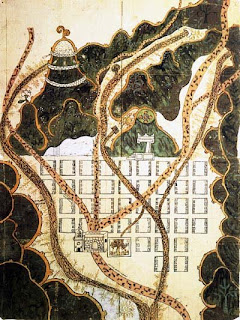We had hoped to locate and excavate at least one elite residence at Calixtlahuaca, but none of the houses we dug are obviously elite houses. So, where did the elites live? One possibility is that we just happened to miss the elite houses at the site, and all of our houses were residences of commoners. Another possibility is that one or two of our excavated houses were indeed the abodes of elite households; they just don’t stand out architecturally like elite houses in other areas. Solving this puzzle is an important part of our analytical research.
What I expected elite houses to look like
My initial expections were based on my prievious fieldwork in the state of Morelos, southeast of the Toluca Valley. One of the nice features of Postclassic sites in Morelos is that its easy to tell commoner houses from elite houses. Commoners lived in small (ca. 25 square meters), one-room adobe houses built at the level of the ground.  Elites, on the other hand, lived in large (ca. 500 square m) sumptuous compounds with better construction methods and many rooms. I excavated two such elite houses, at Cuexcomate (Smith 1992) and Yautepec (Smith, et al. 1999); the Yautepec structure is shown here. It is not possible to confuse elite and commoner houses at these sites in Morelos. Yautepec also has a royal palace (ca. 7,000 square meters), again impossible confuse with other kinds of houses.
Elites, on the other hand, lived in large (ca. 500 square m) sumptuous compounds with better construction methods and many rooms. I excavated two such elite houses, at Cuexcomate (Smith 1992) and Yautepec (Smith, et al. 1999); the Yautepec structure is shown here. It is not possible to confuse elite and commoner houses at these sites in Morelos. Yautepec also has a royal palace (ca. 7,000 square meters), again impossible confuse with other kinds of houses.
So why didn’t we find any large elite structures at Calixtlahuaca? I am excluding consideration of the royal palace here, a huge compound not too different from other Aztec palaces. Could it be that there were simply no elites beyond the royal family at the site? This is extremely unlikely; all known Aztec cities had significant number of elites, generally around 5% of the total population (Smith 2008). So, we either just missed the elite houses, of some of the ones we did excavate did pertain to the elite.
Could units 507 or 509 be elite houses?
The excavations of these two structures are described in earlier posts from the fieldwork season. These are not any larger than other houses at the site, leading to our initial hypothesis that they were commoner houses. But after we had excavated a bunch of houses and none were much larger than the others, the thought comes up that perhaps some of our houses were indeed elite residences.
House 507 was in poor condition. It did yield the densest midden deposit (the infamous 34 bags of sherds).  We have not yet analyzed enough of the ceramics and other artifacts to evaluate whether they could suggest elite consumption patterns. But one thing immediately stood out at this house: lots of copper-bronze objects (mostly bells and bell fragments). A few are shown in the photo. This house yielded nearly half of all the copper we excavated at Calixtlahuaca. Copper bells and tweezers were elite items in Aztec-period
We have not yet analyzed enough of the ceramics and other artifacts to evaluate whether they could suggest elite consumption patterns. But one thing immediately stood out at this house: lots of copper-bronze objects (mostly bells and bell fragments). A few are shown in the photo. This house yielded nearly half of all the copper we excavated at Calixtlahuaca. Copper bells and tweezers were elite items in Aztec-period
House 509 was in somewhat better condition than 507. It showed a pattern found at some other excavations: the house itself had an earth floor, but exterior areas were covered with well-made stone pavements. T he distinctive thing about the material recovered in unit 509 was the presence of a number of stone architectural ornaments. Some of these are shown in the photo. They include “clavos,” tapered cylinders used as architectural ornamentation on Aztec temples and palaces, as well as a stone with thin-line reliefs in a glyph-like pattern. Other excavated houses did not produce anywhere near the quantity of architectural ornaments recovered in unit 509. So perhaps this suggest an elite presence.
he distinctive thing about the material recovered in unit 509 was the presence of a number of stone architectural ornaments. Some of these are shown in the photo. They include “clavos,” tapered cylinders used as architectural ornamentation on Aztec temples and palaces, as well as a stone with thin-line reliefs in a glyph-like pattern. Other excavated houses did not produce anywhere near the quantity of architectural ornaments recovered in unit 509. So perhaps this suggest an elite presence.
How will we evaluate these possibilities? Domestic artifacts are typically good markers of wealth (Smith 1987), and we will use quantified measures based on the artifact inventories of these and other houses to evaluate wealth distributions at the site. We will also consider other likely material indicators of wealth and status (architecture, location within the city, etc.). First, however, we need to get our chronology in order so that we can compare houses and artifacts from particular time periods. Stay tuned.
References
Smith, Michael E. (1987) Household Possessions and Wealth in Agrarian States: Implications for Archaeology. Journal of Anthropological Archaeology 6:297-335.
Smith, Michael E. (1992) Archaeological Research at Aztec-Period Rural Sites in Morelos, Mexico. Volume 1, Excavations and Architecture / Investigaciones Arqueológicas en Sitios Rurales de la Época Azteca en Morelos, Tomo 1, Excavaciones y Arquitectura. University of Pittsburgh Memoirs in Latin American Archaeology vol. 4.
Smith, Michael E. (2008) Aztec City-State Capitals. University Press of Florida, Gainesville.
Smith, Michael E.,




























